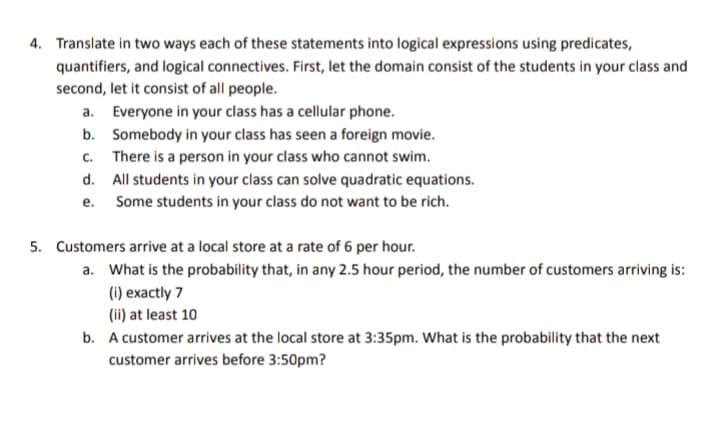4. Translate in two ways each of these statements into logical expressions using predicates, quantifiers, and logical connectives. First, let the domain consist of the students in your class and second, let it consist of all people. a. Everyone in your class has a cellular phone. b. Somebody in your class has seen a foreign movie. c. There is a person in your class who cannot swim.
4. Translate in two ways each of these statements into logical expressions using predicates, quantifiers, and logical connectives. First, let the domain consist of the students in your class and second, let it consist of all people. a. Everyone in your class has a cellular phone. b. Somebody in your class has seen a foreign movie. c. There is a person in your class who cannot swim.
Algebra: Structure And Method, Book 1
(REV)00th Edition
ISBN:9780395977224
Author:Richard G. Brown, Mary P. Dolciani, Robert H. Sorgenfrey, William L. Cole
Publisher:Richard G. Brown, Mary P. Dolciani, Robert H. Sorgenfrey, William L. Cole
Chapter10: Inequalities
Section10.3: Solving Problems Involving Inequalities
Problem 28E
Related questions
Question
Need #4 please help

Transcribed Image Text:4. Translate in two ways each of these statements into logical expressions using predicates,
quantifiers, and logical connectives. First, let the domain consist of the students in your class and
second, let it consist of all people.
a. Everyone in your class has a cellular phone.
b.
C.
Somebody in your class has seen a foreign movie.
There is a person in your class who cannot swim.
All students in your class can solve quadratic equations.
Some students in your class do not want to be rich.
d.
e.
5. Customers arrive at a local store at a rate of 6 per hour.
a. What is the probability that, in any 2.5 hour period, the number of customers arriving is:
(i) exactly 7
(ii) at least 10
b. A customer arrives at the local store at 3:35pm. What is the probability that the next
customer arrives before 3:50pm?
Expert Solution
This question has been solved!
Explore an expertly crafted, step-by-step solution for a thorough understanding of key concepts.
Step by step
Solved in 2 steps

Recommended textbooks for you

Algebra: Structure And Method, Book 1
Algebra
ISBN:
9780395977224
Author:
Richard G. Brown, Mary P. Dolciani, Robert H. Sorgenfrey, William L. Cole
Publisher:
McDougal Littell

Algebra: Structure And Method, Book 1
Algebra
ISBN:
9780395977224
Author:
Richard G. Brown, Mary P. Dolciani, Robert H. Sorgenfrey, William L. Cole
Publisher:
McDougal Littell